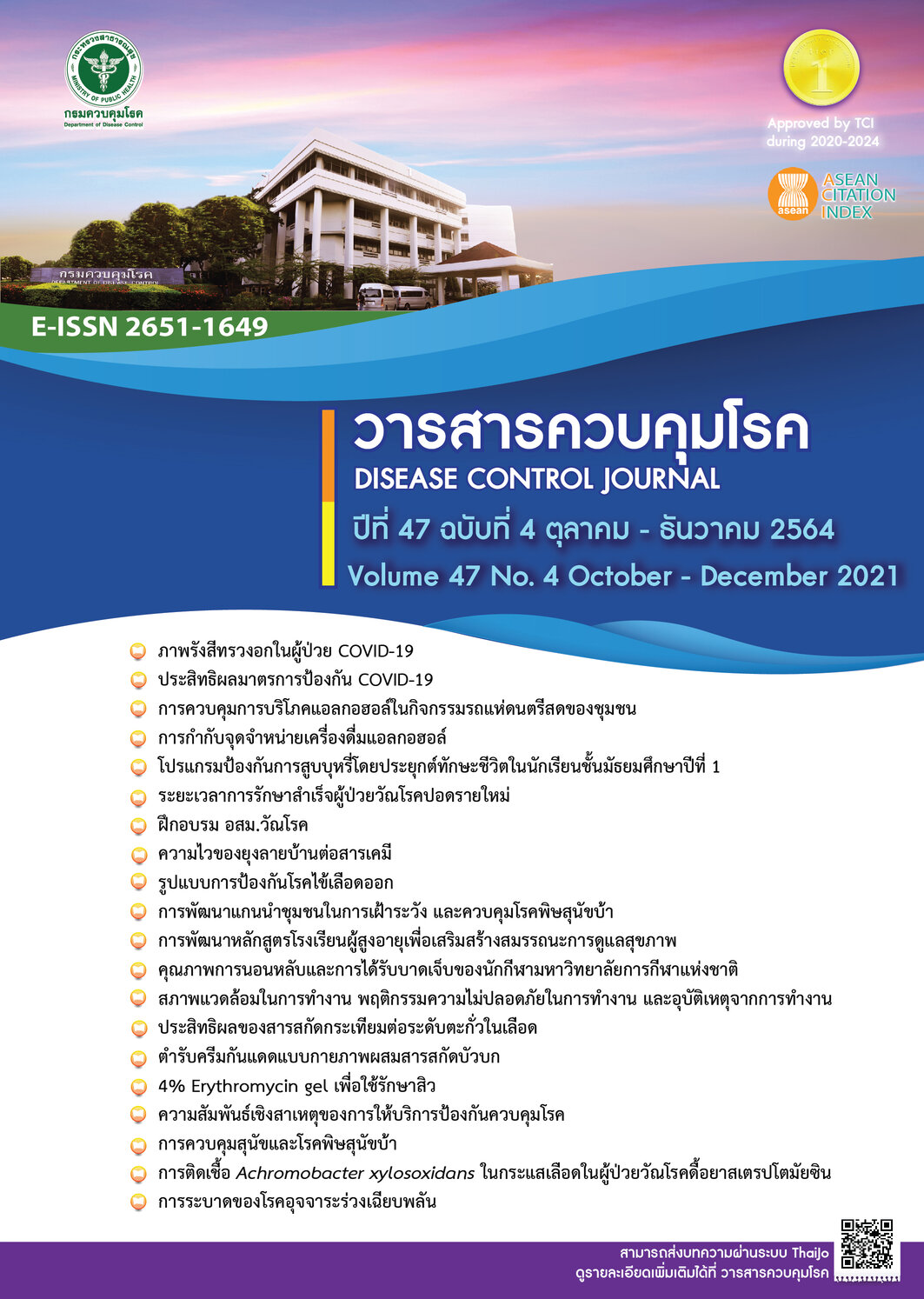Dogs and rabies control in Krabi town municipality
DOI:
https://doi.org/10.14456/dcj.2021.94Keywords:
Dogs and rabies Control, Krabi town municipalityAbstract
Rabies is a vaccine-preventable viral disease. Vaccination of dogs against rabies remains the most cost-efficient way of eliminating dog-mediated human rabies. Krabi Town Municipality authority has to take responsibility for the matter. The objective of the study was to control the dogs and cats in order to control rabies and get rid of an annoyance. Knowledge attituded and practice (KAP) survey was conducted to describe characteristics of communities in the municipal area, and test for independence (Chi-square) with various variables at the significance level 0.05. The program was operated from the fiscal year 2018-2020 (3 years). There were 5,472 owned animals and 2,249 stray animals licensed and vaccinated. It was believed that the control program, by licensing and vaccinating should reach at least 70% of dogs and cats’ population in the municipal area. Sterilization should decrease about 5,000 dog and cat's population, more or less. From a target population of 480 households, 251 households participated in the study (52.29%). Most of the respondents had a lack of comprehensive knowledge about treatable rabies (65.16%) and symptom of rabies dog (71.08%). Approximate 92.00% of respondents agreed to bring their own animals to get a rabies vaccination. 87.10% of respondents agreed to receive post exposure prophylaxis if bitten by animals. 88.76% of respondents did not agree to move unwanted dogs and cats out to be strayed. In a part of a practice, a major problem of not bring their own animals to get rabies vaccination was hard to catch (46.88%), hard to bring to get rabies vaccination (31.25%). Test for independence results revealed that education levels are related to appropriate attitudes at a statistically significant level (p-value=0.006). Age and occupation are related to appropriate practice for prevent rabies at a statistically significant level (p-value = 0.001; p-value=0.014). Adequate knowledge is related to appropriate attitudes at a statistically significant level (p-value < 0.001). In addition, adequate knowledge and appropriate attitude are related to appropriate practice to prevent rabies at a statistically significant level (p-value<0.001; p-value=0.049). Thus, giving education about the right knowledge of rabies prevention and building of understanding the laws and enforcement via different channels could be key factors in how to reach a successful program. And the acceptance that rabies were everyone's problem and responsibility should be accompanied.
Downloads
References
World Health Organization (WHO), Food and Agriculture Organization of the United Nations (FAO), World Organization for Animal Health (OIE) and Global Alliance for Rabies Control (GARC). Zero by 30: the global strategic plan to end human deaths form dog–mediated rabies by 2030. Geneva, 2018.
Crowcroft S N, Thampi N. The prevention and management of rabies. BMJ 2015; 1-5. Doi: 10.1136/bmj. G7827
ASEAN Secretariat. ASEAN Rabies Elimination Strategy. Jakarta, 2016.
Bureau of General Communicable Disease. Department of Disease Control. Guidelines for the Prevention and Control of Rabies. 1sted. Bangkok: Aksorn Graphic and Design Publishing, 2017.
Welutanti A. Guidelines for the Prevention and Control of Rabies [Internet]. [cited 2020 Apr 20]. Available from: http://www.dsdw2016.dsdw.go.th>doc_pr>ndc_2560-2561/PDF/8600e/8600นายอำพันธ์.pdf
Nel L. Global Strategic Plan for the elimination of dog-mediated human rabies. In: Towards Rabies Elimination in Asia-Pacific-From Theory to Practice; 2019 Sep 25-26; Bangkok, Thailand. P. 28.
Bureau of Disease Control and Veterinary Services. Department of Livestock Development. Rabies Situation 13 April 2020 [Internet]. 2020 [cited 2020 Apr 13]. Available from: http://drive.google.com/file/d/1VPK_YHuUsoHTX8ZgAdSE4Rc D7UIOPdb/view
Yamane T. Statistics: An Introduction Analysis. 3rded. New York: Harper and Row Publications; 1973
Sagarasearanee O, Hinjoy S, Chuxnum T, Chantean T, Smithsuwan P, Jorhor N, et al. Survey of knowledge, attitude, and practice initiated by an investigation of a human rabies death in Chanthaburi Province, Thailand 2015. OSIR 2017; 10(3): 1-8.
Gari-unah K, Opaswatcharanon S, Samala W. Knowledge attitude and practice (KAP) survey regarding rabies prevention and control programs in Khok Ngam Sub district, Loei province, Thailand, 2015. WESR 2017; 48(23): 353-358.
Rakpanit S, Vaeteewootacharn K. Factors Associated with Dog Owner,s Behavior on Rabies Prevention in Muang District, Burirum Province*. Journal of Nursing and Health Care 2018; 36(2): 158-166.
Inthongkam N, Preechanvinich I. Dog and Rabies Control in Nakhon Srithammarat Municipal Area. Disease Control Journal 2009; 35(1): 58-65.
Freuling C. Oral vaccination of wildlife: an overview. In: Towards Rabies Elimination in Asia-Pacific-From Theory to Practice; 2019 Sep 25-26; Bangkok, Thailand. P. 20.
Jakava-Viljanen M. Specific aspects with oral vaccines to be used in dogs and various species. In: Towards Rabies Elimination in Asia-Pacific-From Theory to Practice; 2019 Sep 25-26; Bangkok, Thailand. P. 34
Vos A. Oral vaccination against rabies; what prevents us from doing so? In: Towards Rabies Elimination in Asia-Pacific-From Theory to Practice; 2019 Sep 25-26; Bangkok, Thailand. P. 20.
Kasemsuwan S. Oral vaccination of dogs against rabies in Thailand; preliminary studies. In: Towards Rabies Elimination in Asia-Pacific-From Theory to Practice; 2019 Sep 25-26; Bangkok, Thailand. P. 24.
Downloads
Published
How to Cite
Issue
Section
License
Articles published in the Disease Control Journal are considered as academic work, research or analysis of the personal opinion of the authors, not the opinion of the Thailand Department of Disease Control or editorial team. The authors must be responsible for their articles.


.png)



